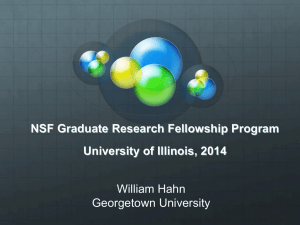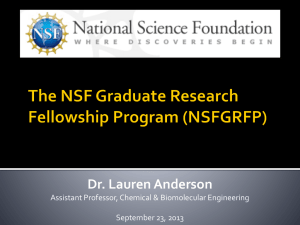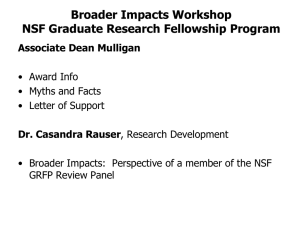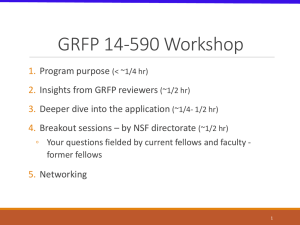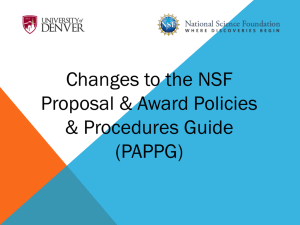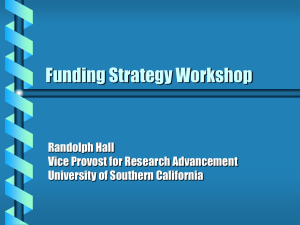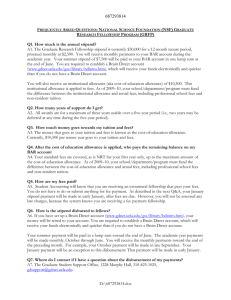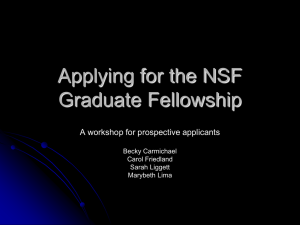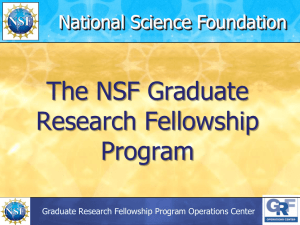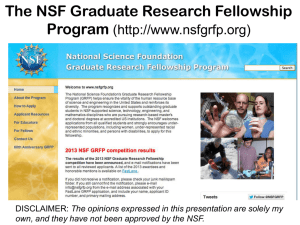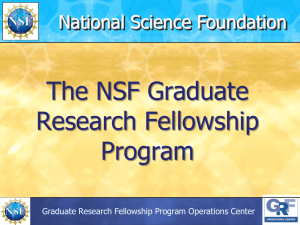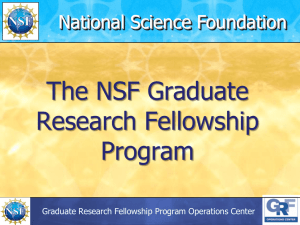NSF Graduate Research Fellowship www.nsf
advertisement
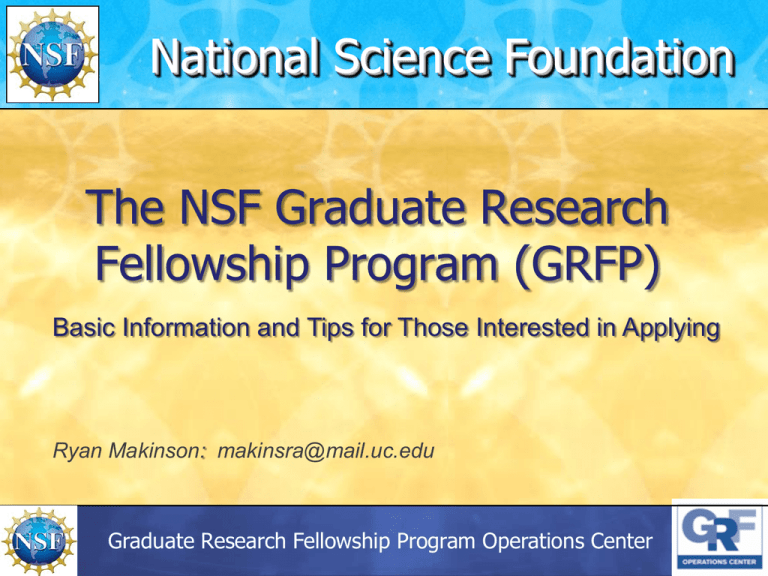
National Science Foundation The NSF Graduate Research Fellowship Program (GRFP) Basic Information and Tips for Those Interested in Applying Ryan Makinson: makinsra@mail.uc.edu Graduate Research Fellowship Program Operations Center Presenter Background • • • 2011 B.S. in Neuroscience and Behavioral Biology from Emory University Current Grad Work: Studying the effects of chronic stress on gene expression in the brain Undergrad Research Experience: – – – – – Center of Disease Control (CDC) IRES Fellow with the Liver Immunology Group, University of Sydney Australia SIRE Fellow with Dr. Charles Nemeroff at Emory U. Yerkes National Primate Research Center; Research supported by the Interdisciplinary Neuroscience Initiative Scholar Fellowship University of North Carolina at Greensboro Research Assistant 2 Presenter Background • Volunteer/Leadership Experience – – – – – – • Resident Advisor at Emory Undergraduate Biology Teaching Assistant Assistant Scout Master with Boy Scouts of America Health Sciences Graduate Student Association (HSGA) Community Service and Outreach Chair University of Cincinnati Program in Neuroscience Student Ambassador Other outreach organizations One first author research publication plus many poster presentations and colloquiums 3 Questions We Had • What is the NSF? Government agency which focuses on improvement of American science & engineering interest and strength • What is the NSF Graduate Research Fellowship Program? Prestigious fellowship for American citizens with great benefits. • Why should I apply? Why not? Paid Schooling, Networking, Not Restricted to Particular Research Area • How is this fellowship different than others? Extremely flexible, Research Freedom, Financial Stability 4 Quick GRFP statistics • $32,000 stipend with $12,000 tuition for 3 years of funding • 2700 new awards annually • 2 current fellows at UC • 14 fellows at UC since 1990 • Top universities in U.S. clean up, e.g. Stanford University had 70 winners in 2012 5 Presentation Outline Intro Materials NSF GRFP Information • Goals, History, and Successes of the Program • Financial Support and Other Resources • Eligibility • Award/Program Cycle & Statistics • Application • Review Criteria Advice • General • Tips NSF Resources Acknowledgements 6 NSF Graduate Research Fellowship Program Goals • To increase the Nation’s human capacity in science and engineering by providing fellowships for early-career graduate students who pursue research-based master’s and doctoral degrees in NSFsupported disciplines • To support the development of a diverse and globally engaged US science and engineering workforce 7 GRFP History & Successes • 48,500 Fellowships awarded since 1952 • 30 Nobel Laureates • 440 members of the National Academy of Sciences • Founders of corporations to authors of books • Higher Ph.D. completion rates • Enhanced diversity 8 Financial Support and Other Resources • Five Year Award – $126,000 • Three years of support • $32,000 Stipend per year • $12,000 Educational allowance to institution • International research opportunities • Access to XSEDE cyberinfrastructure resources 9 GRFP General Eligibility • U.S. citizens, nationals, and permanent residents • Early-career students • Pursuing research-based MS or PhD in NSF fields • Enrolled in accredited U.S. institution by Fall 2013 • Applicants must self-certify in the application that they meet the GRFP Eligibility criteria 10 GRFP Supported Disciplines • • • • • • • • • • • Chemistry Computer and Information Science and Engineering Engineering Geosciences Life Sciences Materials Research Mathematical Sciences Physics and Astronomy Psychology Social Sciences Science, Technology, Engineering and Mathematics Education (researchfocused) 11 Not Supported by NSF GRFP • Business administration or management • Social work/Counseling • Medical, dental, law, or public health programs • Joint science-professional degree programs, e.g., MD/PhD, JD/PhD, etc. • Education (except research-focused STEM Education programs) • See Solicitation (www.nsfgrfp.org) 12 Award/Program Cycle & Statistics • Application: Available online late August • Deadlines: Mid-November (varies by field) • Awards: Announced late March to early April • Best Time to Start Preparing: Now 2012 2,000 Awards 12,064 Applications ~ 17% Success 13 Complete Application NSF FastLane • Personal, Relevant Background and Future Goals Statement (3 pages) • Graduate Research Statement (2 pages) • Transcripts, uploaded into FastLane • Three letters of reference required • Additional information required for some candidates See Solicitation for eligibility requirements (available on www.nsfgrp.org) Review Criteria Two National Science Board-approved Review Criteria: • Intellectual Merit • Broader Impacts 15 Intellectual Merit •How important is proposed activity to advancing knowledge and understanding within its own field or across different fields? •How well qualified is the proposer to conduct the project? •To what extent does the proposed activity suggest and explore creative, original, or potentially transformative concepts? •How well conceived and organized are proposed activities? •Is there sufficient access to resources? •If international activities are proposed, are they relevant and do they benefit applicant? 16 Intellectual Merit Assessment • Academic performance • Research plan • Appropriate choice of institution • References • Research experience 17 Broader Impacts •How well does the activity advance discovery and understanding while promoting teaching, training and learning? •How well does the proposed activity broaden participation of underrepresented groups? •To what extent will it enhance infrastructure for research and education? •Will results be disseminated broadly? •What may be the benefits of proposed activity to society? 18 Broader Impacts Assessment • Prior accomplishments • Future plans • Individual experiences • Potential to reach diverse audiences • Potential benefit to society Read This: http://www.nsf.gov/pubs/gpg/broaderimpacts.pdf 19 Preparing a competitive application Proposed Research Plan (Limit: 2 Pages) • Present a complete plan for a research project that you plan to pursue, demonstrating your understanding of research design and methodology • Explain the relationship to your previous research, if applicable • Address the Intellectual Merit and Broader Impacts of your proposed plan (close to 50/50) • Research topics in your proposed plan must be in fields within NSF’s mission (http://www.nsf.gov/about/) 20 Personal, Relevant Background and Future Goals Statement (3 pages) • How do you envision graduate school preparing you for a career that allows you to contribute to expanding scientific understanding as well as broadly benefit society? Describe your personal, educational and/or professional experiences that motivate your decision to pursue advanced study in science, technology, engineering or mathematics (STEM). Include specific examples of any research and/or professional activities in which you have participated. Present a concise description of the activities, highlight the results and discuss how these activities have prepared you to seek a graduate degree. Specify your role in the activity including the extent to which you worked independently and/or as part of a team. Describe the contributions of your activity to advancing knowledge in STEM fields as well as the potential for broader societal impacts (See Solicitation, Section VI, for more information about Broader Impacts) Preparing a competitive application Reference Letters • Choose at least three reference writers • Give them ample time to prepare their letters • They should know you as a scientist and personally • Share your application materials and the merit review criteria (good letters BOTH judging criteria) • Track letter submission using FastLane; you must have 3 letters for a complete application 22 Preparing a competitive application 1. Read the Solicitation carefully 2. Address the two NSF Merit Review Criteria (Intellectual Merit and Broader Impacts) 3. Check for spelling and grammatical errors 4. Verify essays and transcripts uploads 5. You must certify that this is your own original work 6. You must self-certify your eligibility according to the criteria in the Solicitation 7. Make sure you Press “Submit” button 8. Regularly check application status for # of reference letters 9. Make sure you are enrolled in graduate school by Fall 2014 23 Panelists & Evaluation of Apps. • Panelists are academic and research experts in general discipline, not necessarily in your research topic • Panelists rate your application using the two Merit Review Criteria, Intellectual Merit and Broader Impacts • NSF requests panelists to provide constructive comments (applicants may view) • Panels make recommendations to NSF • NSF awards fellowships and honorable mentions 24 Key Essentials For Applicants • Strong grades (nothing less than 3.5) • Research experience (could depend on field) • Papers & Patents • Passion for making a difference • Talent in the area of research • Supportive Environment • Passionate about outreach activities • Demonstration of successful leadership 25 If you want to give it a shot… • Figure out what you want to research and who you want to do it for/with • Do some independent homework – Gamble Paper: http://newport.eecs.uci.edu/~christoh/nsfadvice.pdf – Jennifer Wang: http://www.jenniferwang.org/nsf.html – Many others too 26 Application Tips: General • Start early: read old solicitation, talk with winners, do homework, etc. • Complete first draft of materials at least one month prior to submittal • Need to write for PhD • Have many audiences read your materials, especially research plan • Frequently visit fastlane to ensure things are done/progressing in application 27 Application Tips: Letters of Recommendation • Reference letters should come from different organizations, i.e. not all UC professors • Ask about writing the letter early • Explain the tone of the letter, i.e. personal and addresses intellectual merit and BI • Offer to write a draft letter so review criteria is met 28 Application Tips: Research Plan • Make Broader Impacts a priority and cover ALL criteria • Follow formatting • Include visual aid where applicable • Enhance readability with defined sections/headers • Strong methodology • Relevant, somewhat newer sources and strong citation use 29 Application Tips: Personal Statement • Tell a story of why you entered the science profession, e.g. NASA, Star Wars, parent influence • List/explain your goals • Explain how the NSF GRFP will help you achieve your research goals • Discus broader impact activities and why you do them • Address recent/active leadership roles and involvement in organizations while at UC 30 Application Tips: Research Statement • Need to convince reviewers that previous experience will aid in proposed work • Link experience with proposed work • Explain roles in work, outcome, and if done individually or in a team • Use headings for readability • BI difficult to tie in here, but do address if appropriate 31 Example Material and Review Ask for sample essays or reviews: makinsra@mail.uc.edu I’d also be more than happy to review your essays or answer any questions. Also ask UC’s other winners: Adam Hehr: hehraj@mail.uc.edu, Eng. Andy Schriner: schrinaw@mail.uc.edu, Eng. Angela Reitler, reitleak@mail.uc.edu, Social Sciences Dan Divelbiss, daniel.divelbiss@gmail.com, Environ. Eng. Prof. Aimee Frame, aimee.frame@uc.edu, Mech. Eng. 32 Resources NSF GRFP Website (nsf.gov/grfp) • Solicitation • FAQ and Guide links Fastlane.nsf.gov/grfp • Online application, user guides, official announcements Phone and email • 866-NSF-GRFP (673-4737) info@nsfgradfellows.org 33 Resources at nsfgrfp.org • Tips for applying • Frequently asked questions (FAQ) • Find GRFP contacts • Important links for the GRFP • Panelist registration 34 Acknowledgements • NSF for amazing award and template for this presentation. • Megan Tischner for organizing and promoting event. • Pam Person for promoting event. 35 Thank you! QUESTIONS? 36
